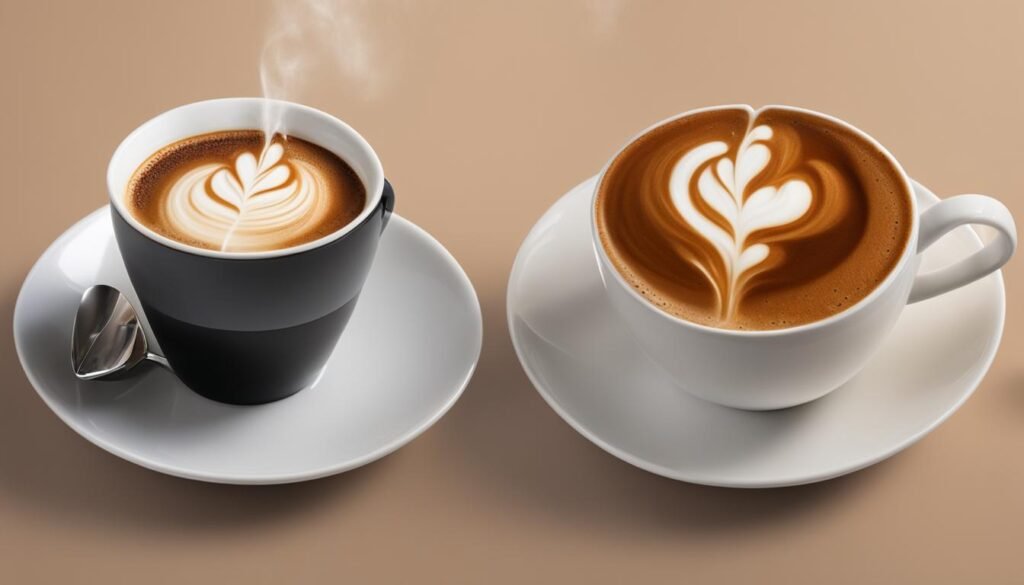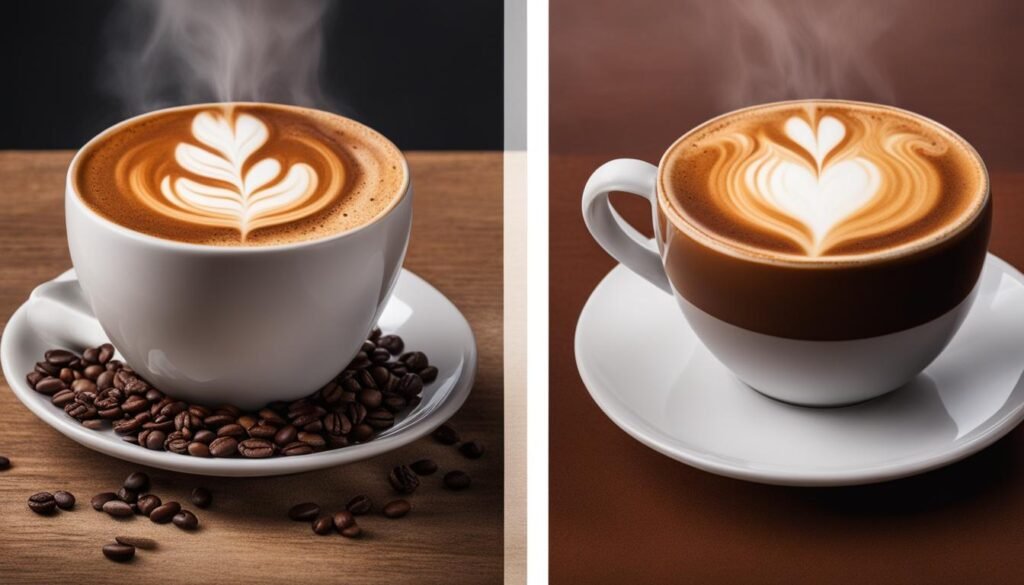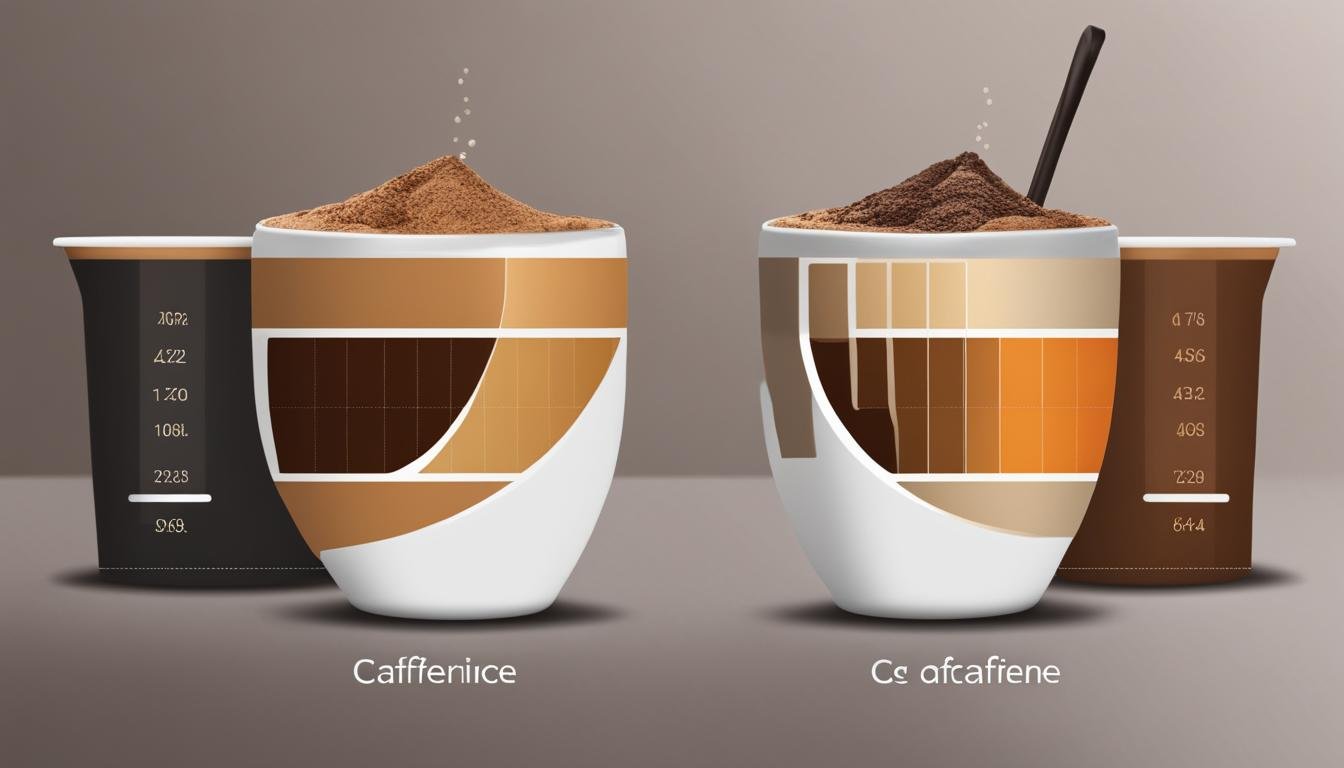Greetings, coffee enthusiasts! Today, we’re diving into the caffeine-filled world of cappuccino and coffee to uncover the truth about their caffeine content. Many of us rely on our daily dose of caffeine to kickstart our mornings or keep us going throughout the day. But have you ever wondered if your beloved cappuccino packs the same punch as a regular cup of joe? Let’s explore the caffeinated wonders of cappuccino and coffee and see how they stack up against each other!
Ah, the delightful aroma of freshly brewed coffee and the frothy goodness of a perfectly crafted cappuccino – they both hold a special place in our hearts and caffeine-loving souls. While these two popular beverages share similarities, such as their Italian origins and the use of coffee as a base, there are key differences in their caffeine content and preparation methods that set them apart.
Key Takeaways:
- Cappuccinos and coffee have differing levels of caffeine content, with brewed coffee typically containing more caffeine than cappuccino.
- An 8-ounce cup of brewed coffee contains around 95mg of caffeine, while a 12-ounce cappuccino contains about 75mg.
- The caffeine content in cappuccino and coffee can vary depending on factors such as the type of beans, brewing method, and serving size.
- Cappuccino is made with equal parts espresso, steamed milk, and milk foam, while coffee can be enjoyed with or without milk and foam.
- The choice between cappuccino and coffee ultimately comes down to personal preferences in caffeine content, taste, and texture.
The Origins of Cappuccino and Coffee
Cappuccino and coffee have a rich history that traces back to Italy, where these beloved beverages were first introduced. The origins of cappuccino can be traced back to the 16th century when Capuchin monks in Italy wore brown robes resembling the color of the coffee drink. The name “cappuccino” pays homage to these monks and their distinctive attire. Coffee, on the other hand, has been a part of Italian culture since the 17th century and quickly gained popularity throughout Europe.
The history of cappuccino and coffee is intertwined with the development and evolution of coffee culture in Italy. From humble origins, these drinks have become ubiquitous across the globe, with countless variations and adaptations to suit different tastes and preferences.
| Origins | Cappuccino | Coffee |
|---|---|---|
| Country | Italy | Italy |
| Timeline | 16th century | 17th century |
| Inspiration | Capuchin monks’ attire | Introduced to Italy |
| Popularity | Developed within Italy | Spread throughout Europe |
As we delve into the origins of cappuccino and coffee, we gain a deeper appreciation for these beverages and the cultural significance they hold. Understanding their roots allows us to savor each sip with a greater sense of connection to the traditions and stories behind the cup.
Main Ingredients in Cappuccino and Coffee
When it comes to cappuccino and coffee, the main ingredients that give these drinks their distinct flavors and textures are espresso, steamed milk, and milk foam. In cappuccino, these three elements are combined in equal parts to create a harmonious balance.
The foundation of both cappuccino and coffee is espresso. Made by forcing hot water through finely ground coffee beans, espresso is a concentrated and slightly bitter form of coffee. It serves as the base for cappuccinos and provides the robust flavor and caffeine kick that many coffee lovers enjoy.
To create a cappuccino, steamed milk is added to the espresso. Steamed milk adds a creamy and velvety texture to the drink, mellowing out the intensity of the espresso. Finally, milk foam is added on top, creating a layer of frothy goodness that completes the cappuccino experience.
Table: Ingredients in Cappuccino and Coffee
| Ingredients | Cappuccino | Coffee |
|---|---|---|
| Espresso | ✓ | ✓ |
| Steamed Milk | ✓ | Optional |
| Milk Foam | ✓ | Optional |
While coffee can be enjoyed with or without milk and foam, cappuccinos are known for their distinctive layering of espresso, steamed milk, and milk foam. These ingredients work together to create a rich and satisfying drink that is beloved by coffee aficionados around the world.
Caffeine Content in Cappuccino and Coffee

When it comes to caffeine content, cappuccino and coffee differ in their levels. The amount of caffeine in each drink primarily depends on the type and quantity of coffee used. While cappuccino contains espresso as its base, brewed coffee is the foundation of traditional coffee. Let’s take a closer look at the caffeine content of both.
Table: Caffeine Content Comparison
| Caffeine Content | |
|---|---|
| Cappuccino (12 oz) | Approximately 75mg |
| Coffee (8 oz) | Approximately 95mg |
The table above showcases the average caffeine content in a standard serving size of cappuccino and coffee. A 12-ounce cappuccino typically contains around 75mg of caffeine, while an 8-ounce cup of brewed coffee contains approximately 95mg. However, it’s important to note that these values can vary depending on factors such as the type of beans, brewing method, and serving size.
Since cappuccinos are made with equal parts espresso, steamed milk, and milk foam, they generally have a milder caffeine content compared to a cup of brewed coffee. The strength and concentration of coffee used in brewed coffee contribute to its higher caffeine levels. It’s worth considering these differences when deciding between the two beverages.
While caffeine content can play a role in choosing between cappuccino and coffee, taste preferences and desired caffeine intake are also important factors to consider. If you enjoy a creamy and velvety texture with a milder caffeine boost, cappuccino might be the ideal choice for you. On the other hand, if you prefer a stronger caffeine kick and a more straightforward coffee flavor, brewed coffee might be the better option. Ultimately, it’s a matter of personal preference and what you’re looking for in your coffee experience.
The Espresso Base in Cappuccino and Coffee

When it comes to cappuccino and coffee, the espresso base plays a crucial role in defining the taste, strength, and caffeine content of these beloved beverages. It’s important to understand how espresso is extracted and the impact it has on your cup of joe. Let’s take a closer look.
Espresso Extraction: Espresso is made by forcing hot water through finely ground coffee beans under high pressure. This extraction method results in a concentrated and slightly bitter coffee that forms the foundation of both cappuccinos and coffee drinks.
Single Shot vs. Double Shot Espresso: The size of the espresso shot can vary, with single shots containing around 68mg of caffeine and double shots containing approximately 136mg. The choice between single or double shots depends on personal preference and desired caffeine intake. The espresso shot provides the base for cappuccinos and coffee, contributing to their caffeine content and flavor profiles.
| Espresso Base | Caffeine Content (per standard shot) |
|---|---|
| Single Shot | Approximately 68mg |
| Double Shot | Approximately 136mg |
As you can see, the espresso base is a key component of cappuccinos and coffee alike. Its extraction process and the size of the shot contribute to the overall caffeine content and flavor profile of your favorite caffeinated beverage. Whether you prefer the subtle layers of steamed milk in a cappuccino or the boldness of a straight shot of espresso, the espresso base is at the heart of your daily cup of joe.
Milk in Cappuccino vs Milk in Coffee: Impact on Caffeine Content
When it comes to cappuccino and coffee, the type and amount of milk used can have an impact on the overall caffeine content of the drink. While milk itself doesn’t contain caffeine, it can affect the concentration of caffeine in the final beverage. In cappuccinos, equal parts of espresso, steamed milk, and milk foam are used, resulting in a milder caffeine content compared to coffee.
Coffee, on the other hand, offers more flexibility in terms of milk additions, allowing for a range of caffeine levels depending on the ratio of coffee to milk. Whether you prefer black coffee, coffee with a splash of milk, or a creamy latte, the amount of caffeine you consume can vary. This makes coffee a popular choice for those seeking a stronger caffeine kick.
To summarize, while milk itself doesn’t contribute to the caffeine content, it plays a vital role in determining the overall caffeine levels in cappuccino and coffee. Whether you opt for a cappuccino or coffee, the milk used and the ratio of coffee to milk will ultimately determine the caffeine content and the overall taste experience.
| Milk in Cappuccino | Milk in Coffee |
|---|---|
| Equal parts of espresso, steamed milk, and milk foam | Various options for milk additions, ranging from black coffee to creamy lattes |
| Milder caffeine content | Varied caffeine levels depending on coffee-to-milk ratio |
| Creamy and velvety texture | Dependent on milk type and amount |
Brewing Techniques: Unveiling the Art behind Cappuccino and Coffee
When it comes to brewing cappuccino and coffee, the techniques used are quite distinct. Each method brings out the unique characteristics and flavors of these beloved beverages. Let’s delve into the brewing processes of cappuccino and coffee, exploring how they contribute to the final taste and experience.
Brewing Process of Cappuccino
Cappuccino starts with a foundation of espresso, extracted using finely ground coffee beans and hot water. The espresso shot is then combined with steamed milk and topped with a layer of velvety milk foam. The key to achieving the perfect cappuccino lies in the careful balance of these three elements: espresso, steamed milk, and milk foam. This meticulous process results in a rich and creamy drink with a delightful combination of flavors.
Brewing Process of Coffee
The brewing process for coffee offers more flexibility and variety. Coffee can be brewed using different methods such as drip, French press, or pour-over. Regardless of the method chosen, the key is to extract the desired flavors from the coffee grounds through the proper ratio of water and coffee. Each brewing technique brings out unique nuances in the flavors, textures, and strengths of the coffee, allowing for a range of taste experiences.
| Brewing Techniques | Description |
|---|---|
| Drip | A popular method that involves pouring hot water over a filter containing ground coffee. The water then drips through the coffee and filter, resulting in a smooth and consistent brew. |
| French Press | A method that involves steeping ground coffee in hot water before pressing a plunger down to separate the coffee grounds from the liquid. The result is a full-bodied and robust cup of coffee. |
| Pour-over | A technique that involves pouring hot water over coffee grounds in a slow and controlled manner, allowing for precise extraction and highlighting the unique flavors of the coffee. |
Understanding the brewing techniques of cappuccino and coffee gives us insight into the artistry and craftsmanship behind these beloved beverages. Whether you prefer the rich and creamy layers of cappuccino or the diverse flavors of brewed coffee, each brewing process contributes to a unique and enjoyable experience.
Varying Degrees of Caffeine in Cappuccino and Coffee

When it comes to caffeine content, there are notable differences between cappuccino and coffee. While coffee generally contains more caffeine than cappuccino, the specific levels can vary depending on various factors, including the type of beans, brewing method, and strength levels.
For those seeking a higher caffeine content, coffee is the go-to option. An 8-ounce cup of brewed coffee typically contains around 95mg of caffeine, providing a strong kick to start the day. However, it’s important to note that the actual caffeine levels can differ based on the specific brewing technique and the type of coffee beans used.
Cappuccinos, on the other hand, offer a milder caffeine boost. A standard 12-ounce cappuccino contains about 75mg of caffeine. The lower caffeine content can be attributed to the equal parts of espresso, steamed milk, and milk foam used in its preparation. While cappuccinos may not provide the same jolt of energy as coffee, they offer a unique flavor experience and a creamy, velvety texture.
The Impact of Brewing Methods on Caffeine Content
The varying degrees of caffeine in cappuccino and coffee can also be attributed to the different brewing methods used. Coffee can be brewed using various techniques such as drip, French press, or pour-over. The brewing process employed can impact the extraction and concentration of caffeine in the final cup. Additionally, factors such as the duration of brewing and water temperature can also influence caffeine levels.
Espresso, which forms the base of cappuccinos, is brewed differently than regular coffee. It involves forcing hot water through finely ground coffee beans at high pressure, resulting in a concentrated and slightly bitter coffee. The brewing process of espresso can significantly impact the caffeine content, with factors such as the size of the espresso shot (single or double) affecting the overall caffeine levels.
| Beverage | Caffeine Content (approx.) |
|---|---|
| Cappuccino (12 oz) | 75mg |
| Brewed Coffee (8 oz) | 95mg |
It’s essential to keep in mind that these numbers are approximate and can vary based on several factors, including the specific brewing techniques, the type and quality of beans used, and the serving size. Additionally, personal preferences for taste, texture, and caffeine intake should also be considered when choosing between cappuccino and coffee.
Customizing Cappuccino and Exploring Alternatives

When it comes to cappuccinos, customization is key to creating a drink that suits your taste preferences. Whether you’re looking to add a personal touch or cater to specific dietary needs, there are plenty of options to explore. Let’s dive into some ways you can customize your cappuccino and discover alternatives to traditional recipes.
Decaf Cappuccino: If you’re sensitive to caffeine or just prefer to limit your intake, decaf cappuccino is a great choice. By using decaffeinated espresso, you can still enjoy the rich flavors and velvety texture of a cappuccino without the buzz of caffeine. It’s a perfect option for those who want to savor the taste without the jolt.
Non-Dairy Cappuccino Options: For those following a dairy-free lifestyle or looking to reduce their dairy consumption, non-dairy milk alternatives can be used to create delicious cappuccinos. Almond milk, soy milk, and oat milk are popular choices that provide a creamy texture and complement the espresso flavors beautifully. Just make sure to choose a non-dairy milk that suits your taste preferences.
Customizing your Cappuccino:
- Add Flavored Syrups: To add a burst of flavor, consider incorporating flavored syrups into your cappuccino. From classic options like vanilla and caramel to more adventurous choices like hazelnut or pumpkin spice, there’s a syrup to suit every palate.
- Experiment with Toppings: Elevate your cappuccino by experimenting with different toppings. A sprinkle of cocoa powder, a drizzle of caramel sauce, or a dusting of cinnamon can add an extra layer of indulgence to your drink.
- Vary the Milk-to-Espresso Ratio: Fine-tuning the proportions of milk to espresso allows you to create a cappuccino that suits your taste. If you prefer a stronger coffee flavor, increase the amount of espresso. If you prefer a creamier and milder taste, add more steamed milk.
With these customization options and alternative choices available, you can enjoy cappuccinos tailored to your preferences. Whether you’re looking to personalize your drink or explore non-traditional variations, the world of cappuccinos is full of possibilities.
Cappuccino vs Coffee: Which Should You Choose?

When it comes to choosing between cappuccino and coffee, personal preferences play a significant role. Your decision should consider factors such as caffeine content and flavor profiles. Let’s explore the key differences to help you make an informed choice.
Caffeine Content
One of the main considerations is the caffeine content. Cappuccinos generally have less caffeine compared to coffee. If you prefer a milder caffeine boost, a cappuccino might be the better choice. On the other hand, if you need a stronger caffeine kick, coffee is likely to provide that extra boost you’re looking for.
Flavor Profiles
Another crucial aspect to consider is the flavor profile. Cappuccinos offer a creamy and velvety texture with layers of steamed milk and milk foam. The combination of espresso and milk creates a balanced and smooth flavor. Coffee, on the other hand, provides a more straightforward and bold flavor profile. It is often associated with a rich and robust taste that coffee lovers appreciate.
Ultimately, the decision between cappuccino and coffee boils down to your personal preferences. If you enjoy a lighter caffeine content and a creamy texture, cappuccinos are a great choice. On the other hand, if you prefer a stronger caffeine kick and a bold flavor, coffee is the way to go. Consider your desired caffeine intake, taste preferences, and overall experience to make the right choice for you.
| Cappuccino | Coffee | |
|---|---|---|
| Caffeine Content | Less caffeine | More caffeine |
| Flavor Profile | Creamy and velvety | Bold and robust |
Conclusion
In conclusion, after exploring the differences between cappuccino and coffee, we can now make a verdict on which one to choose.
If you’re looking for a milder caffeine boost and a creamy, velvety texture, cappuccino is the way to go. With its equal parts of espresso, steamed milk, and milk foam, cappuccinos offer a delightful flavor experience that satisfies both coffee and milk lovers.
On the other hand, if you need a stronger caffeine kick and a more straightforward flavor, coffee is the winner. Brewed coffee contains more caffeine and allows for customization with various brewing methods and milk additions, catering to different taste preferences.
The final decision ultimately depends on your personal preferences and desired caffeine intake. So whether you choose cappuccino or coffee, we hope this article has provided you with the information you need to make an informed choice. Enjoy your cup of caffeine goodness!
FAQ
Does cappuccino have as much caffeine as coffee?
No, cappuccinos typically have less caffeine than coffee.
What is the caffeine content in cappuccino compared to coffee?
A standard 12-ounce cappuccino contains around 75mg of caffeine, while an 8-ounce cup of brewed coffee contains approximately 95mg.
What is the difference in caffeine between cappuccino and coffee?
The main difference in caffeine content between cappuccino and coffee is due to the variation in the amount of espresso, milk, and foam used in each drink.
How much caffeine is there in a cappuccino?
A standard 12-ounce cappuccino contains around 75mg of caffeine.
How much caffeine is there in coffee?
An 8-ounce cup of brewed coffee contains approximately 95mg of caffeine.
What are the main ingredients in cappuccino?
Cappuccino is made with equal parts of espresso, steamed milk, and milk foam.
What are the main ingredients in coffee?
Coffee typically consists of brewed coffee and can be consumed with or without milk and foam.
How does the espresso base impact the caffeine content?
Espresso plays a crucial role in defining the taste, strength, and caffeine content of cappuccinos and coffee. Single shots of espresso contain around 68mg of caffeine, while double shots contain around 136mg.
Does the type and amount of milk affect the caffeine content?
While milk itself does not contain caffeine, it can affect the concentration of caffeine in the final drink. Cappuccinos typically have equal parts of espresso, steamed milk, and milk foam, resulting in a milder caffeine content.
What are the differences in brewing techniques for cappuccino and coffee?
Cappuccinos are made by combining espresso with steamed milk and milk foam, while coffee can be brewed using various methods such as drip, French press, or pour-over.
Are there variations in caffeine levels within cappuccino and coffee?
Yes, the specific caffeine levels can vary depending on factors such as the type of beans, brewing method, and serving size. It’s important to note that these variations exist within each drink category.
Can cappuccinos be customized?
Yes, cappuccinos can be customized by choosing different types of milk, adding syrups or toppings, or even opting for decaffeinated versions. Non-dairy milk options, such as almond milk, soy milk, or oat milk, can also be used to create dairy-free cappuccino alternatives.
How do I choose between cappuccino and coffee?
The choice between cappuccino and coffee ultimately comes down to personal preferences in caffeine content, taste, and texture. Consider your desired caffeine intake, taste preferences, and overall experience when making a decision.

Leave a Reply